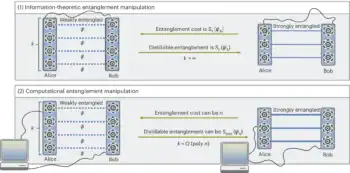
A new experiment has measured the effect of Earth’s rotation on entangled states of light. The experiment, which features an optical fibre-based device called a Sagnac interferometer that its developers describe as the most sensitive ever built, paves the way for even more sensitive tests of gravitational effects on quantum objects.
In a Sagnac interferometer, beams of light travel around the same path, but in opposite directions. If the interferometer is at rest with respect to a non-rotating frame of reference, the travel time for each beam is the same, and recombining the two beams at a detector will produce an ordinary interference pattern. However, if the interferometer is rotating, the interference fringes will be shifted by an amount proportional to the angular velocity. The sensitivity of a Sagnac interferometer depends on the area defined by the paths, so with a large-enough interferometer, it becomes possible to measure even very small rotations with high precision.
Quantum entanglement is a phenomenon in which two or more particles become inextricably linked in ways that do not appear in classical physics. For example, if one photon in a polarization-entangled pair is measured and found to have horizontal polarization, we know immediately that the other photon must be vertically polarized, no matter how far apart they were when the measurement took place. This “spooky action at a distance”, as Albert Einstein called it, was once thought to be a quirky – or even nonsensical – aspect of the quantum world, but it is now a key part of quantum cryptography and quantum communications systems as well as quantum sensors.
The rationale for using entangled photons in a Sagnac interferometer is that they accumulate twice the time difference during their journey around the two paths compared to classical photons that are not entangled, explains Haocun Yu, a Marie Curie Postdoctoral Fellow at the University of Vienna, Austria and a member of the experimental team. “This is a unique property of multi-photon entanglement and is known as super-resolution,” Yu says. “By measuring this time difference, we are able to measure the effect of the rotation of Earth of these entangled particles.”
Keeping noise levels low and stable
The challenge with any quantum device is that entangled states are extremely fragile. Even the tiniest disturbance, or noise, in their environment can cause entangled particles to “decohere” (lose their quantum nature) through random interactions.
With interferometers, this challenge becomes more acute as the area of the device increases. Although larger Sagnac interferometers are better able to detect small rotations, any increase exposes the entangled photon pairs to additional noise.

In the latest work, Yu, team leader Philip Walther and colleagues at Vienna and the Austrian Academy of Science constructed their interferometer by winding a 2-kilometre-long optical fibre around a 1.4 m x 1.4 m rotatable metal frame, giving the device an effective area of more than 700 m2. To keep noise levels low and stable, the researchers wrapped insulation around the fibre (mitigating fluctuations due to changes in temperature and air flow) and performed reference measurements to eliminate some sources of background noise. These measures enabled the device to detect enough high-quality photon pairs to boost its sensitivity by three orders of magnitude compared to previous quantum Sagnac interferometers.
Isolating and extracting the signal
Apart from noise, one of the main challenges the researchers faced was extracting the Earth’s rotation signal from their data. “This meant establishing a reference point for our measurement where light remains unaffected by Earth’s rotation effect,” explains Raffaele Silvestri, a PhD student at Vienna and the lead author of a Science Advances paper on the experiment.
Since they could not stop the Earth from spinning, the researchers devised a workaround, splitting the optical fibre into two equal-length coils and connecting them via an optical switch. “By toggling the switch on and off, we could effectively cancel the rotation signal at will,” Silvestri says. “We basically tricked the light into thinking that it’s in a non-rotating universe.”
Thanks to this approach, the researchers succeeded in measuring a rotation rate with a sensitivity of 5 μrad/s – the highest resolution ever achieved with an optical quantum interferometer.

Optical gyroscope on a chip can detect Earth’s rotation
The researchers say that detecting the Earth’s rotation is a milestone. “Its minute rotation rate, fixed direction and the inability to manipulate its behaviour make it particularly challenging to observe,” Yu says. “What is more, the ubiquitous presence of acoustic and seismic vibrations and thermal fluctuations directly transduce into noise for such a large apparatus.”
The new interferometer will now serve as a prototype for a larger device that the researchers will use to explore how quantum entanglement is influenced by gravitational potential. “Further improvements to our technique will also enable measurements of general-relativistic effects on entangled photons,” Walther says. “This will allow us to explore the interplay between quantum mechanics and general relativity, along with tests for fundamental physics.”



